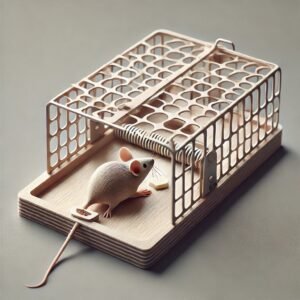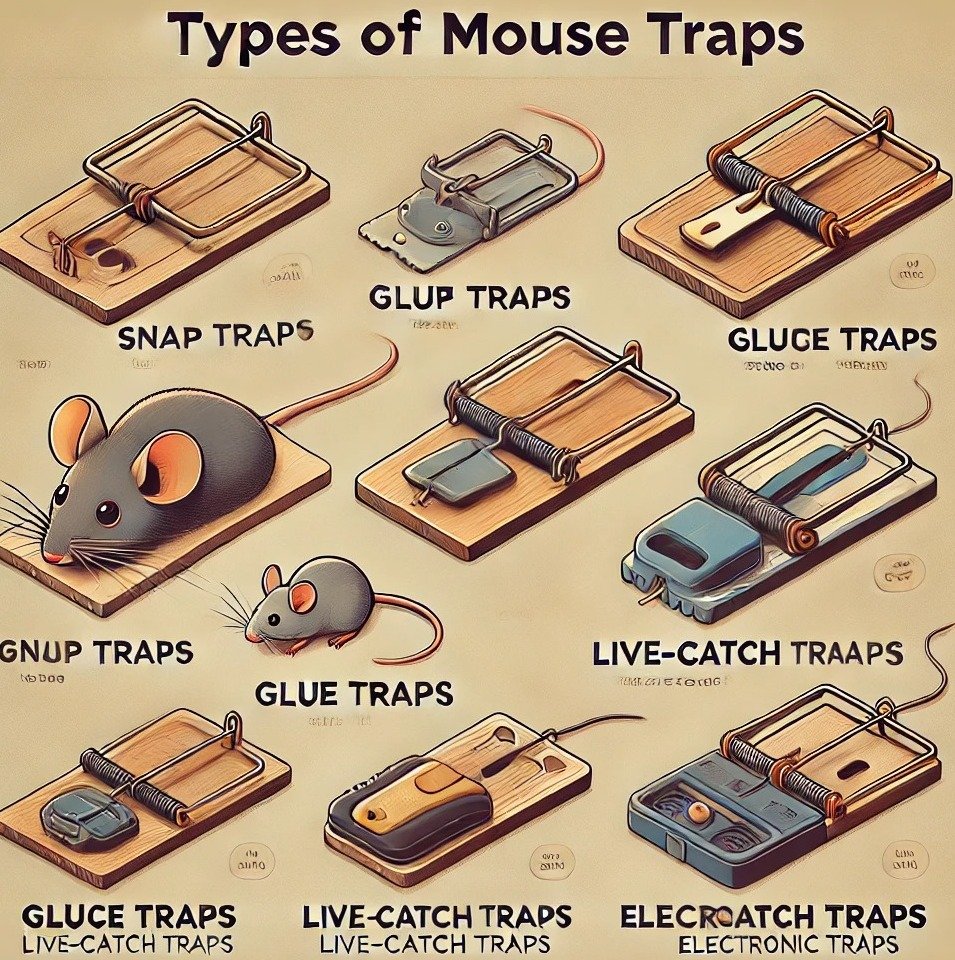Mice infestations can be a persistent problem in both urban and rural settings. These small rodents not only cause damage to property but also pose health risks by spreading diseases through their droppings, urine, and saliva. To manage and mitigate the problem, homeowners and pest control professionals often turn to mouse traps, which have been a reliable solution for decades. The term “mouse traps” refers to a variety of devices designed to capture or kill mice in an efficient and humane manner. This article delves into the different types of mouse traps available on the market, their usage, effectiveness, and tips for optimal results. Mouse traps are essential tools for controlling rodent infestations in homes and businesses.
Table of Contents
ToggleTypes of Mouse Traps
Mouse traps come in various designs, each with its own advantages and limitations. Mouse traps are often seen as a necessary evil, but their use can lead to unintended consequences like harming non-target animals. Understanding the different types can help you choose the most suitable option for your specific situation.
Snap Traps
Snap traps are perhaps the most well-known type of mouse trap. They consist of a spring-loaded bar that snaps down when triggered by a mouse trying to reach the bait. The improper placement of mouse traps in homes can result in lingering odors from trapped and decomposing rodents. This type of trap is highly effective and can kill a mouse instantly, making it a humane option when set up correctly. Snap traps are available in both wooden and plastic models, with the latter being easier to clean and reuse. These traps are best used in areas where you have noticed mouse activity, such as near walls or in dark corners. There are various types of mouse traps, including snap traps, glue traps, live-catch traps, and electronic traps.
Glue Traps
Glue traps are another popular option for capturing mice. While mouse traps are effective, they can sometimes traumatize homeowners, especially when they encounter a caught or struggling mouse. Glue traps are easy to use and dispose of, but they have sparked debate over their humaneness. Unlike snap traps, glue traps do not kill the mouse instantly, leaving the captured rodent to suffer until it is discovered and disposed of. Due to this, some people and organizations advocate against their use, urging others to consider more humane alternatives. Glue traps are traditional and widely used, known for their quick and effective capture method.
Live-Catch Traps
Live-catch traps, also known as humane traps, are designed to capture mice without harming them. The widespread use of mouse traps raises ethical concerns about animal suffering, especially with less humane options like glue traps. These traps usually consist of a small cage with a door that closes once the mouse enters. The captured mouse can then be released far from your home, preventing it from finding its way back. While live-catch traps are favored by those who prefer not to kill animals, they require more effort, as you must check the traps frequently and ensure the mouse is released properly to prevent re-infestation.
Electronic Traps
Electronic traps are a more modern solution to mouse problems. These traps use an electric shock to kill the mouse instantly once it enters the trap. Incorrectly set mouse traps can cause injury to pets and children, making them a potential hazard in households. Electronic traps are highly effective and are often equipped with a light or sound indicator to notify you when a mouse has been caught. Electronic traps use a high-voltage shock to instantly kill mice, offering a modern and efficient solution. They are also designed to be easy to clean and reset, making them a convenient choice for those dealing with larger infestations. However, electronic traps tend to be more expensive than traditional traps, which may be a consideration for some.
Ultrasonic Repellents
While not technically a trap, ultrasonic repellents are worth mentioning. These devices emit high-frequency sound waves that are said to deter mice and other pests from entering an area. Although ultrasonic repellents are marketed as a non-lethal, humane option, their effectiveness is widely debated. Some studies suggest that mice can become accustomed to the sound over time, rendering the device ineffective. As a result, ultrasonic repellents are often recommended as a supplementary measure rather than a primary solution.
Factors to Consider When Choosing a Mouse Trap
Selecting the right mouse trap involves more than just picking the first one you see on the store shelf. These traps are essentially boards coated with a strong adhesive that immobilizes the mouse when it comes into contact. Several factors should be considered to ensure you choose the most effective and suitable trap for your situation.
Infestation Severity
The severity of your mouse infestation will play a significant role in determining which type of trap to use. For small infestations, a few snap traps or live-catch traps may suffice. However, for larger infestations, you may need to consider electronic traps or a combination of different traps to address the problem more efficiently.
Location of Traps
Where you place your mouse traps is crucial to their effectiveness. Mice tend to travel along walls and avoid open spaces, so setting traps near walls, behind furniture, and in dark corners will increase the likelihood of success. It’s also important to place traps in areas where you have noticed signs of mouse activity, such as droppings or chewed food packaging.
Bait Selection
Choosing the right bait is another important consideration. Mice are attracted to high-calorie foods, so using bait such as peanut butter, cheese, or seeds can increase the effectiveness of your traps. Some traps come with bait already included, while others require you to add your own. Be sure to handle bait with gloves to avoid leaving your scent on it, which may deter mice from approaching the trap.
Safety and Pets
If you have pets or small children, safety is a critical factor. Snap traps and electronic traps can be dangerous if accidentally triggered by curious pets or children. In such cases, live-catch traps or enclosed electronic traps that prevent access to the shock mechanism may be safer options. Additionally, consider placing traps in areas that are inaccessible to pets and children, such as behind furniture or in the attic. The effectiveness of a mouse trap depends on proper placement, such as along walls or in areas with visible mouse activity.
Best Practices for Using Mouse Traps
To maximize the effectiveness of your mouse traps, it’s important to follow best practices in their placement and maintenance.
Regular Monitoring
Check your traps regularly to see if they have caught any mice. This is especially important for live-catch and glue traps, as leaving a trapped mouse for too long can result in unnecessary suffering. Regular monitoring also allows you to reset or replace traps as needed, ensuring that they remain effective.
Proper Disposal
Proper disposal of caught mice is essential to prevent the spread of disease and avoid attracting other pests. For snap traps and electronic traps, use gloves to handle the mouse and dispose of it in a sealed plastic bag. The constant need to check and reset mouse traps can lead to increased stress and anxiety for those dealing with a rodent infestation. If using a live-catch trap, release the mouse at least one mile away from your home to prevent it from returning. Regular monitoring and maintenance of mouse traps are necessary to ensure they continue to work effectively. Avoid releasing mice in residential areas, as this may lead to infestations elsewhere. Bait selection is crucial, with peanut butter, cheese, and seeds being popular choices to attract mice.
Preventative Measures
While mouse traps are effective for dealing with current infestations, taking preventative measures can help reduce the likelihood of future problems. Seal any cracks or holes in your home’s exterior to prevent mice from entering. Overreliance on mouse traps without addressing the root cause of the infestation can result in a never-ending cycle of trapping and disposal. Combining mouse traps with preventive measures, like sealing entry points, can help keep your home rodent-free. Store food in airtight containers and keep your home clean to eliminate potential food sources. Additionally, consider setting traps as a precautionary measure in areas where you have previously experienced infestations.
Conclusion
Mouse traps are a time-tested solution for managing and eliminating mouse infestations. Whether you prefer traditional snap traps, humane live-catch traps, or modern electronic traps, understanding the different types and their appropriate usage is key to effectively dealing with these pests. Some people find the use of mouse traps distressing, leading them to seek alternative, more humane methods of pest control. By carefully selecting the right trap, placing it in strategic locations, and following best practices, you can significantly reduce the presence of mice in your home and prevent future infestations. The disposal of dead mice from mouse traps can be a gruesome and unpleasant task that many prefer to avoid. Remember that while traps are effective, they should be used in conjunction with preventative measures to ensure long-term success in keeping your home mouse-free.
ALSO READ
